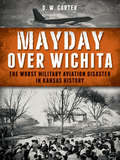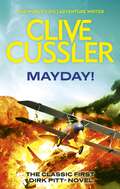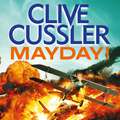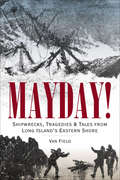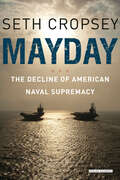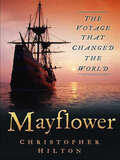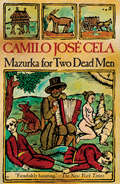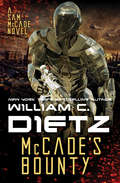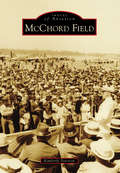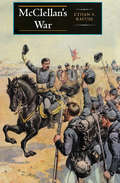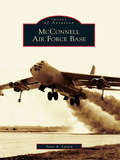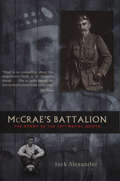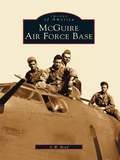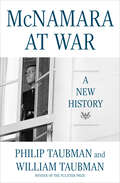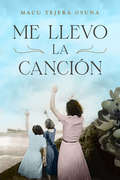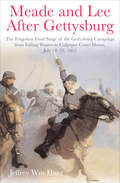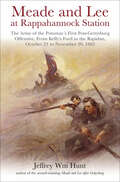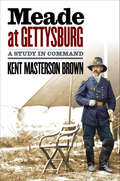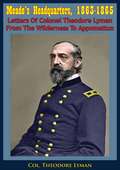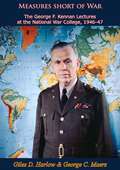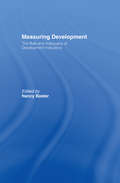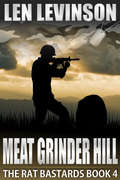- Table View
- List View
Mayday Over Wichita: The Worst Military Aviation Disaster in Kansas History
by D. W. CarterThe little-known story of a major catastrophe in a 1960s African American community: A “commendable, if unsettling, account.” —Richard Kluger, Pulitzer Prize-winning author of Simple JusticeOn the cold Saturday morning of January 16, 1965, a U.S. Air Force KC-135 tanker carrying thirty-one thousand gallons of jet fuel crashed into a congested African American neighborhood in Wichita, Kansas. When the fire and destruction finally subsided, forty-seven people—mostly African American children—were dead or injured, homes were completely destroyed and numerous families were splintered. As shocking as it may sound, the event was seemingly omitted from the historical record for nearly fifty years. Now, historian D. W. Carter examines the myths and realities of the crash while providing new insights about the horrific four-minute flight that forever changed the history of Kansas.Includes photographs
Mayday! (Dirk Pitt #2)
by Clive CusslerA SUNDAY TIMES BESTSELLER'Cussler is hard to beat' Daily MailThe amazing second Dirk Pitt classic from multi-million-copy king of the adventure novel, Clive Cussler.----------------------------------------Major Dirk Pitt picked up the frantic distress call as he cruised his lumbering amphibious plane over the islands of the Aegean. Brady Air Force base was under fire, its entire force of jets destroyed on the ground . . . by just one First World War bi-plane!A psychotic ex-Nazi, a bloodthirsty Greek strongman and a beautiful double agent set Pitt on the trail of the warped mastermind behind a devastating sabotage plot. And on that trail, danger and death are never far behind . . .**********'Clive Cussler is the guy I read' Tom Clancy'The Adventure King' Daily Express
Mayday! (Dirk Pitt #2)
by Clive CusslerA SUNDAY TIMES BESTSELLER'Cussler is hard to beat' Daily MailThe amazing second Dirk Pitt classic from multi-million-copy king of the adventure novel, Clive Cussler.----------------------------------------Major Dirk Pitt picked up the frantic distress call as he cruised his lumbering amphibious plane over the islands of the Aegean. Brady Air Force base was under fire, its entire force of jets destroyed on the ground . . . by just one First World War bi-plane!A psychotic ex-Nazi, a bloodthirsty Greek strongman and a beautiful double agent set Pitt on the trail of the warped mastermind behind a devastating sabotage plot. And on that trail, danger and death are never far behind . . .**********'Clive Cussler is the guy I read' Tom Clancy'The Adventure King' Daily Express
Mayday!: Shipwrecks, Tragedies & Tales from Long Island's Eastern Shore
by Van FieldFrom dramatic rescues to coastal catastrophes, a riveting collection of maritime lore from the eastern shore of Long Island.Since the mid-1600s, eastern Long Island’s shoals, sandbars, and assorted submerged hazards have caused many an unlucky vessel to become shipwrecked. The frequency of wrecks rose to a grim crescendo during the mid-nineteenth century, as New York and New England peaked as shipping centers. Then came the dawn of the twentieth century and the arrival of advanced navigational aids. Although the number of wrecks declined, the high drama persisted—as rumrunners and German submarines kept the coast humming with rumors and anticipation. This book painstakingly assembles a compendium of Long Island’s most harrowing, amazing, and notorious shipwrecks and ocean-going incidents for a thrilling and sometimes terrifying read.
Mayday: The Decline of American Naval Supremacy
by Seth CropseyA naval expert charts the rise and fall of America’s maritime supremacy—and what it means for the future of U.S. security and prosperity.As with other powerful nations throughout history, maritime supremacy has been the key to America’s superpower status and the relative peace of the postwar era. But in the twenty-first century, the United States Navy’s combat fleet has dwindled to historic lows—the smallest since before World War I. At the same time, rival nations such as China have increased the size of their navies at an extraordinary rate. As Seth Cropsey convincingly argues, the precipitous decline of the U.S. as a great seapower will have profound consequences sooner than we might think. In clear and concise language, Mayday tracks the modern evolution of U.S. maritime strength, where it stands now, and the likely consequences if changes are not made to both the Navy’s size and shape and to the United States’ strategic understanding of how to combine maritime and continental force.
Mayflower: The Voyage that Changed the World
by Christopher HiltonThe band of Puritan emigres that left Southampton in 1620 to found a godly colony in Virginia (as the eastern seaboard of the North American continent was known then) carried with them the ideological seed-corn of a new nation. This is the story of their voyage, their settlement in New England and the influence they had on the forging of a nation.
Mazurka for Two Dead Men
by Camilo José CelaA New York Times Best Book of the Year Nobel Prize Laureate Mazurka for Two Dead Men, the culmination of Camilo José Cela‘s literary art, opens in 1936 at the beginning of the Spanish Civil War: Lionheart Gamuzo is savagely murdered. In 1939, as the war ends, his brother avenges his death. For both deaths, the blind accordion player Gaudencio plays the same mazurka. Set in backward rural Galicia, Cela’s excellent novel portrays a reign of fools, and works like contrapuntal music, its themes calling and responding, alternately brutal, melancholy, funny, lyrical, and coarse.
Mañana no será lo que Dios quiera
by Luis García MonteroLa biografía novelada del genial poeta Ángel González, fruto del diálogo que mantuvo con el escritor y amigo Luis García Montero en sus últimos años de vida. El poeta Ángel González dejó una de las obras líricas más relevantes en lengua española, pero también fue testigo privilegiado de uno de los períodos más convulsos en la historia reciente de España: la Guerra Civil. Luis García Montero construye el retrato del poeta y recorre los primeros años de su vida para rescatar la mirada de un niño que tuvo que crecer sin la figura de su padre, pero con toda la fuerza de una familia y una geografía que se resistían con uñas y dientes a dejarse vencer. Mañana no será lo que Dios quiera es un homenaje a un territorio, a una familia, a los amigos y a los libros, que levantaron el espíritu del joven en ciernes que con el tiempo se transformaría en uno de los más grandes y premiados poetas de este país durante el siglo XX.Luis García Montero construye en Mañana no será lo que Dios quiera el retrato del poeta Ángel González. Una novela que pretende ser el testimonio de una realidad, escrita con humor, admiración y ternura. Reseñas:«La novela que me gustaría cantar. Una de las mejores canciones de amor que he leído. La historia de España vivida en primera persona.»Joaquín Sabina «Un relato hermoso y singular, la recuperación emocionante de la memoria de un niño de la guerra que habría de convertirse en uno de los grandes poetas españoles de la posguerra.»José Manuel Caballero Bonald «Un libro sorprendente que aúna la precisión de una biografía con el caudal narrativo de una novela. Un testimonio conmovedor y deslumbrante sobre un poeta, sobre una época, sobre la vida misma.»Felipe Benítez Reyes «Un relato hermoso y singular, una recuperación emocionante de la memoria de un niño de la guerra que habría de convertirse en uno de los grandes poetas españoles de la posguerra. Una novela, en definitiva, que pretende ser el testimonio de una realidad, escrita con humor, admiración y ternura.»Jurado del Premio de Librerías de Madrid
McCade's Bounty (Sam McCade #4)
by William C. DietzThe interstellar bounty hunter searches for his kidnapped daughter in this suspenseful adventure by a New York Times–bestselling author. Six years ago, McCade and his men destroyed the deep-space empire of pirate Mustapha Pong. Now Pong's back--with a vengeance. He's kidnapped McCade's daughter. This time, there's no reward. The bounty belongs to McCade--and it's personal.
McChord Field (Images of Aviation)
by Kimberly PetersonMcChord Field, tucked away in the Pacific Northwest, maintains an understated presence. Yet this subdued outpost plays a vital role in major conflicts around the world. On July 3, 1940, McChord officially opened as a training base, developing bomber crews for aircraft such as B-17s, B-18s, B-25s, B26s, and even some of the Doolittle Raiders. Strategically located, McChord functioned as an aircraft modification center, producing P-39s, the Soviet Union's most venerable aircraft, as well as a homeland defense center during World War II. The dawning of the Cold War expanded air defense operations with the newly formed Air Defense Command, receiving the P-61, followed by the F-86, F-102, F-106, and F-15. A global airlift hub using C-124s, C-141s, and C-17s, McChord has supported humanitarian, Antarctic, and wartime missions for America.
McClellan's War: The Failure Of Moderation In The Struggle For The Union
by Ethan S. Rafuse&“An important book that rescues George B. McClellan&’s military reputation.&” —Chronicles Bold, brash, and full of ambition, George Brinton McClellan seemed destined for greatness when he assumed command of all the Union armies before he was 35. It was not to be. Ultimately deemed a failure on the battlefield by Abraham Lincoln, he was finally dismissed from command following the bloody battle of Antietam. To better understand this fascinating, however flawed, character, Ethan S. Rafuse considers the broad and complicated political climate of the earlier 19th Century. Rather than blaming McClellan for the Union&’s military losses, Rafuse attempts to understand his political thinking as it affected his wartime strategy. As a result, Rafuse sheds light not only on McClellan&’s conduct on the battlefields of 1861-62 but also on United States politics and culture in the years leading up to the Civil War. &“Any historian seriously interested in the period will come away from the book with useful material and a better understanding of George B. McClellan.&” —Journal of Southern History &“Exhaustively researched and lucidly written, Rafuse has done an excellent job in giving us a different perspective on &‘Little Mac.&’&” —Civil War History &“Rafuse&’s thoughtful study of Little Mac shows just how enthralling this complex and flawed individual continues to be.&” —Blue & Gray magazine
McConnell Air Force Base (Images of Aviation)
by Steve A. LarsenBeginning from its earliest days as an empty parcel of pasture that became a major hub airport for transcontinental air travel to its present use as the busiest refueling operation in the U.S. Air Force, the slice of land known as McConnell Air Force Base is inextricably connected to aviation to nearly the dawn of manned flight. Its military history began in 1941 with the arrival of the Air National Guard, and the base grew to a multifaceted operation that extends air power globally through intelligence and air refueling missions performed by its three partner units: the 22nd Air Refueling Wing, the 184th Intelligence Wing, and the 931st Air Refueling Group. This book offers a glimpse into the military history of McConnell Air Force Base through many rarely seen or previously unpublished images drawn primarily from the repository of the 22nd Air Refueling Wing Office of History and the Kansas Aviation Museum.
McCrae's Battalion: The Story of the 16th Royal Scots
by Jack AlexanderMcCrae's Own was the 'Heart of Midlothian Battalion' mentioned all too briefly in Martin Middlebrook's classic book The First Day on the Somme. Raised in Edinburgh shortly after the start of the Great War, it was perhaps the finest unit in Lord Kitchener's volunteer army - a brotherhood of sportsmen, bound together by their extraordinary colonel and their loyalty to a quaintly named Association Football club, the famous Gorgie 'Hearts'. McCrae's were blooded in the Battle of the Somme, losing three-quarters of their strength on the first day alone. The Colonel himself was invalided home. In time the battalion recovered. It came of age at Arras, endured the muddy horror of Passchendaele, and held the line unbroken in the face of furious German attacks on the Lys in 1918. For almost a century their story remained untold. It was all but lost forever. Now, after 12 years of exacting historical detective work, Jack Alexander has reclaimed the 16th Royal Scots for posterity. In this stirring book he draws upon interviews with veterans and a unique archive of letters, diaries and photographs, assembled from the families of more than 1,000 of Sir George McCrae's men.
McGuire Air Force Base (Images of America)
by G. W. BoydMcGuire Air Force Base, built on property ceded by the Boy Scouts of America, the Civilian Conservation Corps, and the contiguous Fort Dix, has served the nation proudly for decades. Originally, it was intended to be used as a home for observation antisubmarine reconnaissance aircraft and army support as Fort Dix Army Air Field, but the focus of the base quickly changed as a result of its strategic location. McGuire Air Force Base recounts the contributions of this military asset with more than two hundred photographs from the archives of the U.S. Air Force and the U.S. Army. Among its many achievements, McGuire was the first American military base to become operational with the F-106 Delta Dart; the first base to operate an all-jet military transport, the C-135 Stratolifter; and finally, the first base to become operational with a ground-launched antiaircraft nuclear missile squadron. In the 1950s, McGuire became the air force's principal aerial port on the East Coast-a role it continues to this day.
McNamara at War: A New History
by Philip Taubman William TaubmanA revelatory portrait of Robert S. McNamara, informed by newly discovered diaries, letters, and interviews with those closest to him. Robert S. McNamara was widely considered to be one of the most brilliant men of his generation. He was an invaluable ally of Presidents John F. Kennedy and Lyndon B. Johnson as U.S. secretary of defense, and he had a deeply moving relationship with Jackie Kennedy. But to the country, McNamara was the leading advocate for American escalation in Vietnam. He strongly advised Johnson to deploy hundreds of thousands of American ground troops, just weeks before concluding that the war was unwinnable, and for the next two and a half years, McNamara failed to urge Johnson to cut his losses and withdraw. McNamara at War examines McNamara’s life of intense personal contradictions, following his childhood, his career as a young faculty member at Harvard Business School, and his World War II service, to his leadership of the Ford Motor Company and the World Bank. Philip and William Taubman had access to materials previously unavailable to McNamara biographers, including Jacqueline Kennedy’s warm letters to McNamara during the Kennedy and Johnson administrations and beyond; family correspondence dating back to McNamara’s service in World War II; and a secret diary maintained by McNamara’s top Vietnam policy aide. What emerges is the comprehensive story of the infamous former leader of the Pentagon: riven by melancholy, guilt, zealous loyalty, and a profound inability to admit his flawed thinking about Vietnam before it was too late. McNamara at War is a portrait of a man at war with himself—with a grave influence on the history of the United States and the world.
Me llevo la canción
by Macu TejeraUna inolvidable novela que nos relata los años convulsos y apasionantes del exilio español en México, escrita por la guionista de Amar en tiempos revueltos. Un libro que nos habla del amor, de las nuevas oportunidades y del poder arrollador de la esperanza Junio 1939. Una multitud se reúne en el puerto de Veracruz para recibir a los españoles que descienden del barco Sinaia, primer buque fletado por Negrín para salvar a los republicanos de la represión desatada en España. Entre ellos se encuentran los pintores Somoza y Marcial, leales defensores de la República, el arquitecto Eduardo Toledo, capitán durante la guerra de un batallón de fortificaciones, con su familia, y los hermanos fotógrafos Gabino, Mauricio y Daniel Estrella. A la vez que intenta abrirse camino como arquitecto en la patria de acogida, y mientras la guerra que ha estallado en Europa se extiende por Asia, África y América, Eduardo Toledo buscará la manera de liberarse del recuerdo de un episodio de la batalla del Ebro que le impide reconstruir su vida y su matrimonio con Blanca. Otros compañeros de viaje, como el pintor Pepe Somoza, optará por volver a Francia y arriesgar de nuevo su vida luchando con el maquis por la libertad. Por su parte, Gabino Estrella trabajará fotografiando el país desde el aire para el presidente Cárdenas y se enamorará en secreto de Blanca, la única persona capaz de librarle del vacío que le ha dejado la pérdida de su mujer. Macu Tejera nos guía por la vida de estos personajes, trazando un bello y conmovedor relato de unos años clave en la historia de España, México y Europa.
Meade and Lee After Gettysburg: The Forgotten Final Stage of the Gettysburg Campaign from Falling Waters to Culpeper Court House, July 14–31, 1863
by Jeffrey Wm HuntThis &“very satisfying blow-by-blow account of the final stages of the Gettysburg Campaign&” fills an important gap in Civil War history (Civil War Books and Authors). Winner of the Gettysburg Civil War Round Table Book Award This fascinating book exposes what has been hiding in plain sight for 150 years: The Gettysburg Campaign did not end at the banks of the Potomac on July 14, but deep in central Virginia two weeks later along the line of the Rappahannock. Contrary to popular belief, once Lee&’s Army of Northern Virginia slipped across the Potomac back to Virginia, the Lincoln administration pressed George Meade to cross quickly in pursuit—and he did. Rather than follow in Lee&’s wake, however, Meade moved south on the east side of the Blue Ridge Mountains in a cat-and-mouse game to outthink his enemy and capture the strategic gaps penetrating the high wooded terrain. Doing so would trap Lee in the northern reaches of the Shenandoah Valley and potentially bring about the decisive victory that had eluded Union arms north of the Potomac. The two weeks that followed resembled a grand chess match with everything at stake—high drama filled with hard marching, cavalry charges, heavy skirmishing, and set-piece fighting that threatened to escalate into a major engagement with the potential to end the war in the Eastern Theater. Throughout, one thing remains clear: Union soldiers from private to general continued to fear the lethality of Lee&’s army. Meade and Lee After Gettysburg, the first of three volumes on the campaigns waged between the two adversaries from July 14 through the end of July, 1863, relies on the official records, regimental histories, letters, newspapers, and other sources to provide a day-by-day account of this fascinating high-stakes affair. The vivid prose, coupled with original maps and outstanding photographs, offers a significant contribution to Civil War literature. Named Eastern Theater Book of the Year byCivil War Books and Authors
Meade and Lee at Rappahannock Station: The Army of the Potomac's First Post-Gettysburg Offensive, From Kelly's Ford to the Rapidan, October 21 to November 20, 1863
by Jeffrey Wm HuntThe third installment of this award-winning Civil War series offers a vivid and authoritative chronicle of Meade and Lee’s conflict after Gettysburg.The Eastern Theater of the Civil War during the late summer and fall of 1863 was anything but inconsequential. Generals George Meade and Robert E. Lee clashed in cavalry actions and pitched battles that proved that the war in Virginia was far decided at Gettysburg. Drawing on official reports, regimental histories, letters, newspapers, and other archival sources, Jeffrey Wm Hunt sheds much-needed light on this significant period in Meade and Lee at Rappahannock Station.After Gettysburg, the Richmond War Department sent James Longstreet and two divisions from Lee’s army to reinforce Braxton Bragg’s Army of Tennessee. Washington followed suit by sending two of Meade’s corps to reinforce William Rosecrans’ Army of the Cumberland. Despite his weakened state, Lee launched a daring offensive that drove Meade back but ended in a bloody defeat at Bristoe Station on October 14th.What happened next is the subject of Meade and Lee at Rappahannock Station, a fast-paced and dynamic account of Lee’s bold strategy to hold the Rappahannock River line. Hunt provides a day-by-day, and sometimes minute-by-minute, account of the Union army’s first post-Gettysburg offensive action and Lee’s efforts to repel it. In addition to politics, strategy, and tactics, Hunt examines the intricate command relationships, Lee’s questionable decision-making, and the courageous spirit of the fighting men.
Meade at Gettysburg: A Study in Command (Civil War America)
by Kent Masterson BrownAlthough he took command of the Army of the Potomac only three days before the first shots were fired at Gettysburg, Union general George G. Meade guided his forces to victory in the Civil War's most pivotal battle. Commentators often dismiss Meade when discussing the great leaders of the Civil War. But in this long-anticipated book, Kent Masterson Brown draws on an expansive archive to reappraise Meade's leadership during the Battle of Gettysburg. Using Meade's published and unpublished papers alongside diaries, letters, and memoirs of fellow officers and enlisted men, Brown highlights how Meade's rapid advance of the army to Gettysburg on July 1, his tactical control and coordination of the army in the desperate fighting on July 2, and his determination to hold his positions on July 3 insured victory. Brown argues that supply deficiencies, brought about by the army's unexpected need to advance to Gettysburg, were crippling. In spite of that, Meade pursued Lee's retreating army rapidly, and his decision not to blindly attack Lee's formidable defenses near Williamsport on July 13 was entirely correct in spite of subsequent harsh criticism. Combining compelling narrative with incisive analysis, this finely rendered work of military history deepens our understanding of the Army of the Potomac as well as the machinations of the Gettysburg Campaign, restoring Meade to his rightful place in the Gettysburg narrative.
Meade’s Headquarters, 1863-1865: Letters Of Colonel Theodore Lyman From The Wilderness To Appomattox [Illustrated Edition]
by George R. Agassiz Col. Theodore LymanIncludes Civil War Map and Illustrations Pack - 224 battle plans, campaign maps and detailed analyses of actions spanning the entire period of hostilities.Originally published in 1922, this book is a collection of letters written by Maj. Gen. George Meade's aide-de-camp, Theodore Lyman, to his wife Mimi.A fascinating first-hand account of the Army of the Potomac from just after Gettysburg to the end of the war. Not only are military battles and life discussed, but the relationships between Grant, Meade, Butler and the other generals are explored in great detail.A great book for anyone interested in American Civil War history.
Measures short of War: The George F. Kennan Lectures at the National War College, 1946-47
by Giles D. Harlow George C. MaerzThe current transition to a post-Cold War world is in certain ways reminiscent of the immediate post-World War II years. Then, amidst the euphoria of victory over the Axis powers, the Allies immediately had to face new problems, among them the threat of nuclear weapons, the necessity of rebuilding Europe and stabilizing Japan, and the need to contain Communist expansionism across the globe. Today, the West has had precious little time to celebrate the end of the Cold War before turning to the destabilizing problems of Soviet disintegration and the blatant military aggression of Iraq.This volume holds the unpublished lectures and other writings of George F. Kennan at the National War College in its first academic year, 1946-47. Kennan and his generation, having won the war, faced the challenges of winning the peace. This they did, by creating and fostering the policies and structures that we now often take for granted: the Marshall Plan, the concept of containment, and institutions such as the US Department of Defense, NATO, and the United Nations. The National War College itself was an experiment in co-educating military and civilian leaders.As the first Deputy for Foreign Affairs at the War College, George Kennan had no small role in shaping these developments. His 1946-47 lectures and papers, specially edited for this book in collaboration with Professor Kennan, document his thinking on many critical national security topics of those days when the Iron Curtain was falling across much of the world.Kennan’s patterns of sound, critical thinking, his idealism tempered by realism, his intellectual rigor and command of history, and his repeated insistence on America’s internal moral and social strength as essential components of national power all help make Measures Short of War valuable reading for any historian or student of international affairs.
Measuring Army Deployments to Iraq and Afghanistan
by Dave BaiocchiThis report summarizes Army deployment statistics to Iraq and Afghanistan through December 2011. It serves as an update to the 2008 report Army Deployments to OIF and OEF (DB-587-A).
Measuring Development: the Role and Adequacy of Development Indicators
by Nancy BasterFirst published in 1972. Routledge is an imprint of Taylor & Francis, an informa company.
Measuring the Quality of Care for Psychological Health Conditions in the Military Health System: Candidate Quality Measures for Posttraumatic Stress Disorder and Major Depressive Disorder
by Elizabeth M. Sloss Susan D. Hosek Katherine E. Watkins Coreen Farris Harold Alan Pincus Carrie M. Farmer Caroline Epley Kimberly A. Hepner Carol P. Roth Grant R. Martsolf Daniel MandelTo inform improvements to the quality of care delivered by the military health system for posttraumatic stress disorder and major depressive disorder, researchers developed a framework and identified, developed, and described a candidate set of measures for monitoring, assessing, and improving the quality of care. This document describes their research approach and the measure sets that they identified.
Meat Grinder Hill
by Len LevinsonHell's Choir of Killers! The quiet of the jungle is shattered by a single command. The air fills with voices of death. A Texas cattle call. An Apache war whoop. A piercing scream of bloody blue murder. And a killing chorus of zinging hot lead. A mighty green wave surges up the hill. The Rat Bastards are on the rampage, and what the enemy began, they are about to finish...The Rat Bastards.
